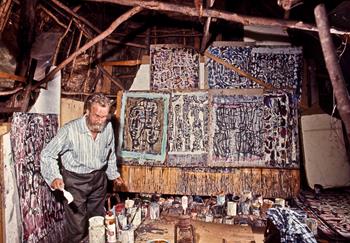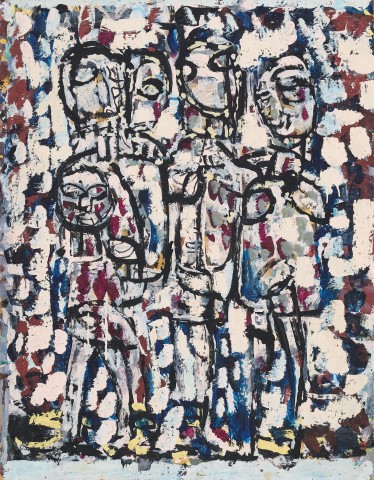FIGURE GROUP V, 1968 – 69
IAN FAIRWEATHER
synthetic polymer paint and gouache on cardboard on board
96.5 x 75.0 cm
Macquarie Galleries, Sydney
Mr and Mrs G Scott
Philip Bacon Galleries, Brisbane
Private collection, Perth, purchased from the above January 1985
Thence by descent
Private collection, Sydney
Recent Paintings Ian Fairweather, Macquarie Galleries, Sydney, 28 October – 9 November 1970, cat. 17 (label attached verso)
Ian Fairweather 1891-1974 Tenth Anniversary Exhibition, Philip Bacon Galleries, Brisbane, 18 May – 14 June 1984, cat. 79 (label attached verso, illus. in exhibition catalogue p.29)
Side by Side, Art Gallery of Western Australia, Perth, 12 August – 8 October 2000 (label attached verso, as ‘Figure Group’)
Finding Fairweather, Rockhampton Art Gallery, Rockhampton, Queensland, 4 March – 12 November 2017
McGregor, C. (et. al), Australian Art and Artists - In the Making, Thomas Nelson, Melbourne, 1969, p.145 (illus., in studio photograph)
Bail, M., Fairweather, Murdoch Books, Sydney, revised edition, 2009, p.271 (illus. in studio photograph)
Standing figures I, 1968, reproduced in Bail, M., Ian Fairweather, Bay Books, Sydney & London, 1981, p. 214
Standing figures II, 1967-68, reproduced in Goddard, A., Ian Fairweather: late works 1953-74, exhibition catalogue, Queensland Art Gallery, Brisbane, 2012, p. 86
Figure Group IV, 1970, synthetic polymer paint and gouache on card on board, Deutscher and Hackett, Sydney, 28 April 2010, lot 14
dh200649_IAN FAIRWEATHER IN HIS STUDIO HUT, BRIBIE ISLAND, QUEENSLAND, 1968.jpg

By the time Ian Fairweather started Figure group V, 1968-69, he was 77 years old and had been living on Queensland’s Bribie Island for fifteen years. When he first encountered the island in March 1945, he was so entranced that he stayed for seven months in an empty beekeeper’s hut, relishing the view of the distant Glasshouse Mountains and the ‘sunset across the channel (which) comes right to the doorstep – one feels almost in it.’1 Enhancing its appeal was the relative isolation of the island, as access could only be gained via a ferry. This all changed in 1963 when a road bridge was constructed, and regular loads of day-trippers started to arrive. As the fame spread of this legendary art figure, Fairweather became a local curiosity but in spite of this physical intrusion, the visitors’ presence actually began to enhance his work and jostling images of figure groups started to appear regularly in his multi-layered compositions.
Part of the mythic appeal of the Fairweather story was that he was a hermit, but this is incorrect. True, he lived in deliberately straitened circumstances in hand-built huts amidst the pines, with the island’s grey sand as a floor, but this was because he had no need for modern conveniences and sought an austere simplicity to his life. He had always been restless, living for periods in numerous countries, or travelling on a whim under bizarre circumstances, like the ill-advised raft journey to Timor in 1952. A partial cause for this wandering was his sad and unusual childhood, but it was also his deep study of Zen, of the concept of everything and nothing-ness, that directed his actions. Unlike a hermit, Fairweather kept in regular touch with the outside world, subscribed to newspapers and journals, and welcomed a regular series of guests to Bribie Island. He was a solitary man, but one with an active and enquiring mind.
Allied to his Zen studies was a rich knowledge of calligraphy, and the sinuous lines of this ancient practice are present at every stage of his mature paintings. Fairweather preferred to work simultaneously on many works and, as John Olsen recorded in his diary, all of the walls of the hut ‘were covered with paintings. It was like a little temple, adorned within these marvellous images, out there in the scrub.’2 This practice is vividly displayed in a photograph from c.1968 that shows the artist (dressed up for the camera in clean shirt and trousers) before a tableau of eight works-in-progress, with our lot visible in the upper right. Of these, at least three are figure groups which allow the viewer to explore the artist’s strategy as he accumulates his lines into dense webs of texture and colour, flickering into different directions as new shapes are suggested or memories are evoked. This often meant that most of a painting’s original brush marks would be buried under new paint in the process. Particularly evident in Figure group V is the effect of dappled light as seen through the pine trees by day, depicted by Fairweather using broad patches of off-white that also serve to unify the background.
1. Bail, M., Ian Fairweather, Bay Books, Sydney & London, 1981, p.74
2. John Olsen, diary entry 1961. Quoted in Olsen, J., Drawn from Life, Duffy & Snellgrove, Sydney, 1997, p.52
ANDREW GAYNOR
